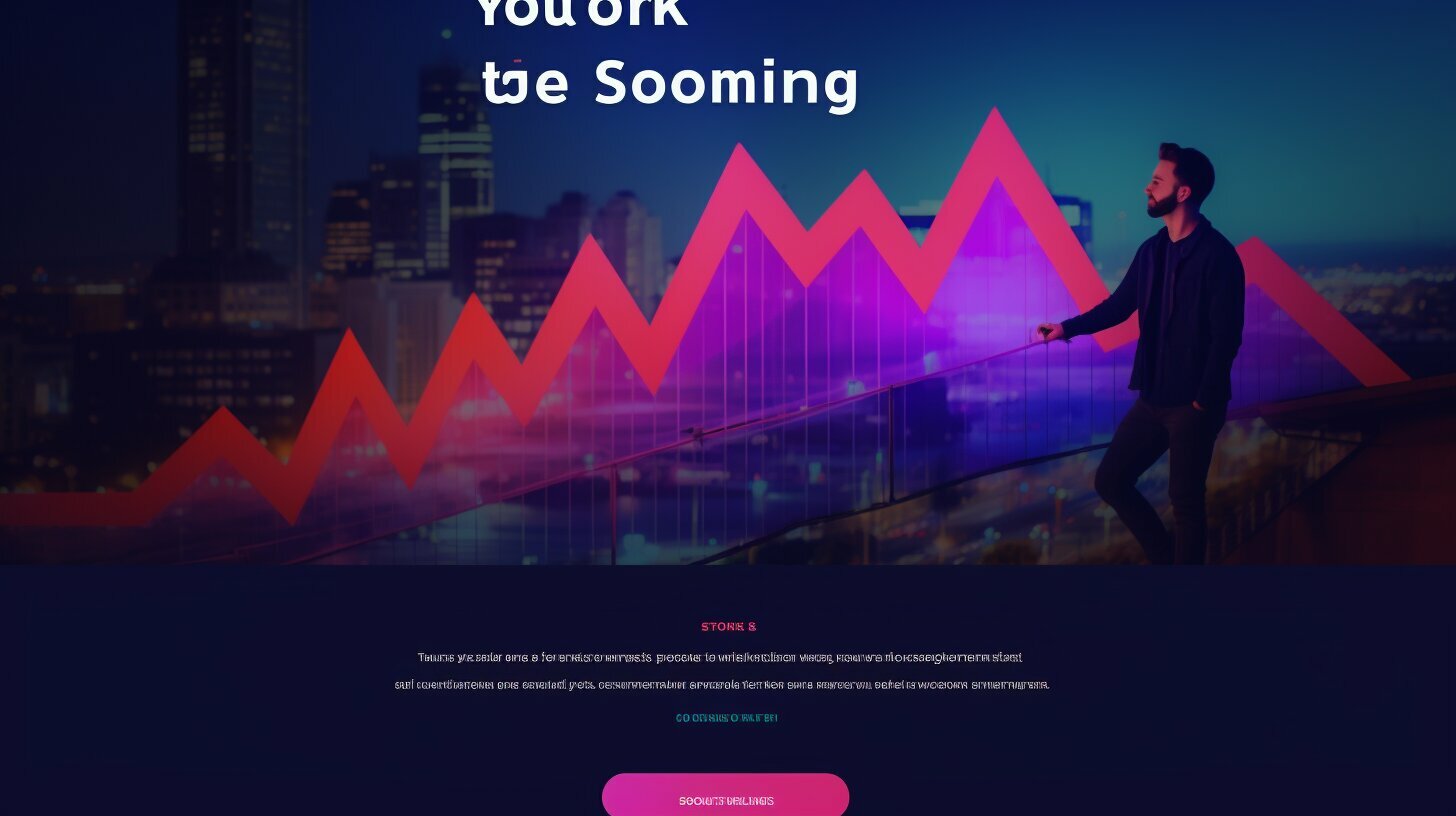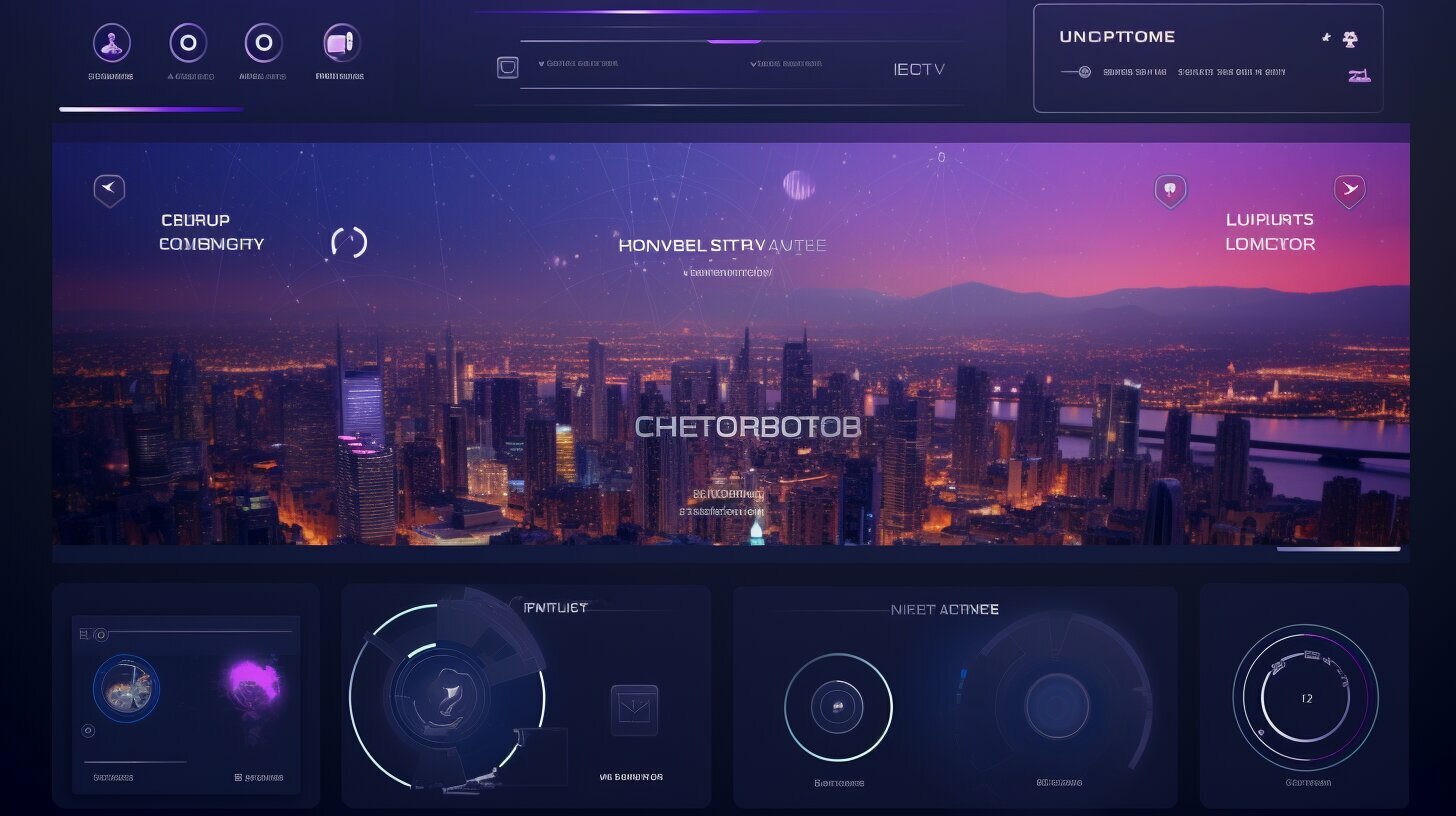Optimizing landing pages for higher conversions is crucial for improving sales and the success of digital marketing campaigns. A well-optimized landing page can significantly increase the chances of capturing leads and driving conversions. To achieve this, businesses need to focus on landing page optimization strategies that resonate with their target audience and compel them to take action.
Key Takeaways:
- Create unique landing pages tailored to different audience segments to engage them effectively.
- Segment landing pages based on traffic sources to improve overall conversions.
- Increase the desire to take action by using persuasive copywriting, compelling offers, and effective call-to-action elements.
- Test different layouts to optimize for maximum impact and improve website conversions.
- Eliminate distractions on landing pages to create better focus and increase conversion rates.
By implementing these strategies and utilizing tools like Google Analytics, Crazy Egg, Optimizely, Unbounce, VWO, and Hotjar, businesses can optimize their landing pages for higher conversions and maximize their digital marketing efforts. Remember, the key to success lies in continuous testing, analyzing data, and implementing improvements based on user behavior and preferences.
The Importance of Landing Page Optimization
Improving conversion rates and increasing website conversions are key goals in digital marketing, and landing page optimization plays a vital role in achieving these objectives. A well-optimized landing page is crucial for capturing the attention of visitors, engaging them, and compelling them to take the desired action.
One of the main benefits of landing page optimization is its ability to improve conversion rates. By optimizing the content, design, and user experience of a landing page, businesses can create a seamless and persuasive journey for their visitors, increasing the likelihood of conversions. Whether the desired action is making a purchase, filling out a form, or subscribing to a newsletter, an optimized landing page can significantly impact the conversion rate.
Furthermore, landing page optimization also helps in increasing website conversions. By directing traffic to specific landing pages tailored to different campaigns or target audiences, businesses can enhance the relevance and personalization of their messaging. This level of customization strengthens the connection between visitors and the products or services being offered, ultimately increasing the chances of converting them into customers.
| Benefits of Landing Page Optimization | Key Objectives |
|---|---|
| Improved conversion rates | Increase website conversions |
| Enhanced user experience | Boost sales |
| Increased relevance and personalization | Improve customer engagement |
The Role of Conversion Rate Optimization (CRO)
Conversion rate optimization (CRO) is a key component of landing page optimization. CRO involves analyzing user behavior, conducting A/B tests, and making data-driven decisions to optimize landing pages for maximum effectiveness. By implementing CRO strategies, businesses can continually fine-tune their landing pages, identify areas for improvement, and increase the likelihood of conversions.
In summary, landing page optimization is a crucial aspect of digital marketing. It helps improve conversion rates, increase website conversions, and enhance the overall user experience. By implementing effective optimization techniques, utilizing the right tools, and constantly evaluating performance, businesses can maximize the effectiveness of their landing pages and drive more conversions.
Creating Unique Landing Pages for Different Audiences
To maximize conversions, it is essential to create unique landing pages that cater to the specific needs and preferences of different audience segments. Effective landing page design plays a crucial role in boosting conversions and engaging target groups effectively. By tailoring landing pages to different audiences, businesses can enhance the user experience, increase relevance, and ultimately drive more conversions.
When creating landing pages for different audiences, it is important to consider factors such as demographics, interests, and buying behaviors. By conducting thorough market research and analyzing customer data, businesses can gain insights into their target audience and create landing pages that resonate with their needs and motivations.
One effective way to cater to different audience segments is through personalized messaging and content. By addressing the specific pain points and desires of each audience group, businesses can establish a stronger connection and increase the likelihood of conversions. This can be achieved by showcasing relevant product features, benefits, and testimonials that align with the specific audience’s interests and goals.
Table 1: Examples of Unique Landing Pages for Different Audience Segments
| Audience Segment | Landing Page Design |
|---|---|
| Millennials | Modern, visually appealing design with interactive elements and social media integration |
| Business Professionals | Clean, professional design with clear value propositions and case studies demonstrating tangible results |
| Parents | Warm, family-oriented design with testimonials from satisfied parents and a focus on safety features |
In addition to personalized content, businesses should also consider optimizing landing page navigation to ensure a seamless user experience. By providing a clear path to conversion and reducing friction points, businesses can make it easier for visitors to take the desired action, whether it’s making a purchase, submitting a form, or signing up for a newsletter.
By investing time and effort into creating unique landing pages for different audiences, businesses can significantly boost their conversion rates. By understanding the specific needs and preferences of each audience segment and tailoring landing pages accordingly, businesses can increase relevance, engagement, and ultimately drive more conversions.
Segmenting Landing Pages by Traffic Source
Segmenting landing pages based on traffic source is a powerful strategy for increasing conversion rates and driving higher engagement with specific audience segments. By tailoring landing pages to the unique needs and preferences of different traffic sources, businesses can provide a more personalized and relevant user experience, ultimately leading to higher conversion rates.
One effective way to segment landing pages by traffic source is to analyze the various channels through which visitors are accessing your website. This can include organic search, paid advertising, social media, email marketing, and more. By understanding where your traffic is coming from, you can create landing pages that align with the specific expectations and interests of those users.
For example, if you’re running a paid advertising campaign on Facebook targeting a specific demographic, you can create a landing page that speaks directly to that audience. You can customize the messaging, imagery, and call-to-action to appeal to their specific desires and pain points. By doing so, you increase the likelihood of capturing their attention and convincing them to take the desired action.
By segmenting landing pages based on traffic source, businesses can optimize their marketing efforts and increase conversion rates. It allows for better targeting, more personalized messaging, and a higher level of engagement with specific audience segments. With the right tools and techniques, businesses can create landing pages that effectively convert traffic into leads or customers, driving the success of their digital marketing campaigns.
| Benefits of Segmenting Landing Pages by Traffic Source |
|---|
| Higher conversion rates |
| Improved targeting and personalization |
| Increased engagement with specific audience segments |
| Optimized marketing efforts |
Increasing Desire to Take Action
Increasing the desire of visitors to take action on landing pages is key to boosting conversions and achieving marketing objectives. By implementing effective conversion optimization techniques, businesses can create a compelling user experience that motivates visitors to take the desired action, whether it’s making a purchase, subscribing to a newsletter, or filling out a contact form.
One powerful technique for boosting conversions is persuasive copywriting. Engaging and compelling copy can capture the attention of visitors and persuade them to take action. By highlighting the benefits of a product or service, addressing pain points, and using strong calls-to-action, businesses can create a sense of urgency and drive conversions.
Another effective strategy is to offer compelling incentives or offers. By providing exclusive discounts, free trials, or limited-time promotions, businesses can entice visitors to take action immediately. These offers should be prominently displayed on the landing page and be easy to understand and redeem.
Additonally, effective call-to-action elements play a crucial role in boosting conversions. Clear and visually appealing buttons, placed strategically on the page, can draw attention and guide visitors towards the desired action. Utilizing contrasting colors, persuasive language, and a sense of urgency can further enhance the effectiveness of call-to-action elements.
| Conversion Optimization Techniques | Examples |
|---|---|
| Persuasive Copywriting | “Unlock your full potential with our revolutionary training program!” |
| Compelling Incentives | “Get 50% off your first purchase when you sign up today!” |
| Effective Call-to-Action Elements | “Claim your free e-book now!” |
By implementing these conversion optimization techniques and creating a user-friendly, persuasive landing page, businesses can significantly increase conversions and achieve their marketing goals. Continuously testing and refining these elements, based on data-driven insights, can further optimize the landing page and maximize its conversion potential.
Testing Layouts for Maximum Impact
Testing different layouts on landing pages is crucial to optimize for maximum impact and improve overall website conversions. By experimenting with various designs and analyzing the data, businesses can gain insights into what works best for their target audience and make data-driven decisions to enhance their landing pages.
One effective method for testing layouts is A/B testing, where two versions of a landing page are created with one key difference. This could be a variation in the placement of elements, the color scheme, or the overall design. By splitting the traffic evenly between the two versions and tracking the conversion rates, businesses can determine which layout performs better and implement the winning design.
Another useful testing method is usability testing, which involves collecting feedback from users to evaluate the user experience and identify any issues or areas for improvement. This can be done through surveys, interviews, or even observing users interacting with the landing page. Usability testing helps uncover potential obstacles or confusion that users may face, allowing businesses to make necessary adjustments to optimize the layout and enhance the overall user experience.
Example of A/B Testing Results:
| Version A | Version B |
|---|---|
| Conversion Rate: 10% | Conversion Rate: 15% |
| Number of Clicks: 500 | Number of Clicks: 450 |
In the provided example, Version B outperformed Version A with a higher conversion rate of 15% compared to 10%. Additionally, Version B received fewer clicks but still managed to generate more conversions, indicating that the layout of Version B was more effective in driving action from visitors.
By regularly testing layouts and continuously optimizing landing pages based on the results, businesses can create a user-friendly and visually appealing experience that maximizes conversions and boosts overall website performance.
Eliminating Distractions for Better Focus
Eliminating distractions on landing pages is essential to create a better focus and maximize conversion rates. When visitors arrive on a landing page, their attention should be directed towards the primary goal – taking the desired action, such as making a purchase or filling out a form. By minimizing distractions, businesses can increase the chances of visitors staying engaged and converting.
One effective way to eliminate distractions is by reducing clutter on the landing page. Keep the design clean and simple, with a clear and focused message. Avoid using excessive images, videos, or excessive text that may divert attention away from the intended call-to-action. Use whitespace strategically to visually separate different elements and guide the user’s attention towards the most important parts of the page.
Another distraction to consider is unnecessary navigation. Landing pages should not have navigation menus that allow visitors to explore other areas of the website. By removing navigation options, businesses can prevent visitors from getting sidetracked and ensure they remain on the landing page until they complete the desired action.
| Benefits of Eliminating Distractions on Landing Pages: | How to Achieve It: |
|---|---|
| – Increased conversion rates | – Keep the design clean and simple |
| – Improved user experience | – Use whitespace strategically |
| – Enhanced focus on call-to-action | – Remove unnecessary navigation |
By eliminating distractions on landing pages, businesses can create a seamless user experience and increase the likelihood of conversions. The key is to keep the design simple, use whitespace effectively, and remove unnecessary navigation.
Streamlining the User Experience
One aspect of eliminating distractions is streamlining the user experience. It’s important to ensure that visitors can easily navigate through the landing page and understand the value proposition. By following these best practices, businesses can create a focused and effective landing page:
- Use a clear headline and subheadings to communicate the key message
- Place the call-to-action prominently on the page and use contrasting colors to make it stand out
- Minimize form fields and only ask for essential information
- Optimize page loading speed to prevent visitors from abandoning the page
By implementing these strategies and providing a seamless user experience, businesses can increase the chances of visitors staying engaged and converting on their landing pages.
With the elimination of distractions, a streamlined user experience, and a clear focus on the call-to-action, businesses can optimize their landing pages for higher conversion rates. By following these tips and utilizing the right tools, businesses can maximize the effectiveness of their landing pages and drive more conversions.
Optimizing Landing Pages for Mobile Devices
Optimizing landing pages for mobile devices is crucial to accommodate the growing number of users accessing websites through smartphones and tablets. With mobile usage on the rise, businesses need to ensure that their landing pages are responsive, fast-loading, and provide a seamless user experience across different screen sizes.
One key aspect of optimizing for mobile devices is responsive design, which allows the landing page to automatically adapt to the user’s device, providing an optimal layout and readability. This ensures that the content remains easily accessible and visually appealing on smartphones, tablets, and other mobile devices. Additionally, fast loading times are essential for mobile users who expect instant access to information. A delay of just a few seconds can significantly impact user engagement and conversion rates.
Another important consideration is to incorporate mobile-friendly features such as click-to-call buttons, simplified forms, and easy navigation menus. These features streamline the user experience, making it effortless for mobile users to interact with the landing page and take desired actions. By optimizing landing pages for mobile devices, businesses can effectively engage and convert the growing number of mobile users, ultimately increasing website conversions.
| Key Points |
|---|
| Optimize landing pages for mobile devices to accommodate the increasing number of smartphone and tablet users. |
| Implement responsive design for seamless user experience across different screen sizes. |
| Ensure fast loading times to prevent user abandonment. |
| Incorporate mobile-friendly features for easy navigation and interaction. |
Ensuring Security and Trustworthiness
Building trust and ensuring security on landing pages is vital to increase conversion rates and foster long-term customer relationships. When visitors feel confident in the safety and reliability of a website, they are more likely to take the desired action, whether it’s making a purchase, submitting their contact information, or signing up for a newsletter.
To establish trust, it’s important to prominently display trust symbols, such as SSL certificates and payment gateway logos, to assure visitors that their personal information is secure. Research shows that websites with visible security indicators experience higher conversion rates. In fact, a study by GlobalSign found that 85% of consumers are more likely to complete a transaction when they see security logos on a website.
Testimonials and customer reviews also play a crucial role in building trust. By showcasing positive feedback from satisfied customers, businesses can instill confidence in their offerings and establish credibility. Including real names, photos, and even video testimonials can further enhance trustworthiness and authenticity.
| Trust Symbols | Testimonials and Reviews |
|---|---|
| Secure SSL certificates | “I am amazed by the quality of the products and the excellent customer service. Highly recommended!” – John Doe |
| Payment gateway logos | “This company has exceeded my expectations. Their products are top-notch, and the delivery was prompt.” – Jane Smith |
| Industry-specific security certifications | “The team at ABC Company went above and beyond to ensure my satisfaction. I will definitely be a repeat customer.” – Michael Johnson |
SSL Certificates: Creating a Secure Connection
One of the most critical trust symbols is the SSL certificate, which encrypts data transmitted between a visitor’s browser and the website. This encryption ensures that sensitive information, such as credit card details or contact forms, is protected from unauthorized access. With data breaches and online fraud on the rise, the presence of an SSL certificate is paramount. In fact, a study by GlobalSign revealed that 80% of online shoppers consider the presence of an SSL certificate before providing personal information on a website.
- Choose a reputable Certificate Authority (CA) to issue your SSL certificate
- Ensure that your SSL certificate is valid and up to date
- Display the SSL certificate seal prominently on your landing page
- Use secure payment gateways to process transactions
By implementing these security measures and instilling trust in visitors, businesses can increase conversion rates and build lasting relationships with their customers.
Incorporating Social Proof for Credibility
Incorporating social proof on landing pages is a powerful strategy to establish credibility and increase conversions. When potential customers see that others have had a positive experience with your product or service, it builds trust and confidence in your brand. There are several effective ways to incorporate social proof into your landing pages:
- Customer Testimonials: Display testimonials from satisfied customers who have benefited from your product or service. Include their name, photo, and a brief testimonial that highlights the key benefits they experienced.
- Case Studies: Share success stories of how your product or service solved specific problems for your customers. Include relevant data and metrics to demonstrate the effectiveness of your solution.
- Social Media Proof: Showcase social media mentions, reviews, or endorsements from influential individuals or well-known brands. This helps to validate your offering and build credibility.
By incorporating social proof, you can alleviate any doubts or hesitations that potential customers may have and nudge them towards taking the desired action on your landing pages. It provides reassurance that others have had a positive experience, making it more likely for visitors to convert into customers.
Example:
“After implementing the recommendations from the case study provided by [Company Name], our website conversions increased by 30%. The results were beyond our expectations, and it’s clear that their product is a game-changer for our business.”
– John Smith, CEO of X Company
As illustrated in the example above, incorporating social proof through testimonials and case studies can have a significant impact on the perceived trustworthiness of your landing pages. Make sure to strategically place social proof elements throughout your landing page and tailor the content to align with the needs and preferences of your target audience.
| Social Proof Element | Benefits |
|---|---|
| Customer Testimonials | Build trust, credibility, and highlight the benefits of your product or service. |
| Case Studies | Showcase real-world examples of how your product or service solves problems and delivers results. |
| Social Media Proof | Validate your offering through endorsements and positive mentions from influential individuals or brands. |
Remember, incorporating social proof is just one aspect of landing page optimization. By implementing a combination of conversion optimization techniques and utilizing the right tools, you can enhance the effectiveness of your landing pages, increase conversions, and achieve your marketing goals.
Tracking Conversions and Assessing Data
Tracking conversions and assessing data are crucial steps in optimizing landing pages for maximum effectiveness and improved results. By carefully monitoring the performance of landing pages and analyzing the gathered data, businesses can identify areas for improvement and make data-driven decisions to enhance conversion rates. This section will explore the various tracking and assessment techniques that can be utilized to optimize landing pages.
One of the key tools in tracking conversions is Google Analytics. With its comprehensive set of features, businesses can easily track and measure important metrics such as bounce rate, click-through rate, and conversion rate. By analyzing these metrics, businesses can gain valuable insights into visitor behavior, identify areas of high engagement or drop-offs, and make informed decisions to optimize landing pages accordingly.
Another effective tool is Crazy Egg, which provides heat mapping and scroll mapping features. These features allow businesses to visualize visitor behavior and identify specific areas of interest or attention on landing pages. By analyzing heat maps and scroll maps, businesses can gain insights into which sections of the landing page are receiving the most attention and optimize those sections for better conversions.
| Tool | Features |
|---|---|
| Google Analytics | – Comprehensive tracking and measurement capabilities – Insights into visitor behavior – Key metrics analysis |
| Crazy Egg | – Heat mapping and scroll mapping – Visualization of visitor behavior – Identification of areas of interest |
| Optimizely | – A/B testing capabilities – Multivariate testing – Personalization features |
| Unbounce | – Landing page builder – Easy integration with other tools – Conversion tracking and analysis |
Additionally, tools like Optimizely and Unbounce can also be used to optimize landing pages. Optimizely offers A/B testing and multivariate testing capabilities, allowing businesses to experiment with different variations of their landing page and determine the most effective design or layout. Unbounce, on the other hand, is a powerful landing page builder that enables businesses to create high-converting landing pages and easily track conversions for analysis and optimization.
By utilizing these tools and implementing effective tracking and assessment techniques, businesses can gain valuable insights into visitor behavior, identify areas of improvement, and optimize landing pages for maximum conversions. The combination of data-driven decision-making and the right tools can significantly enhance the effectiveness of landing pages and contribute to improved results in digital marketing campaigns.
Utilizing Tools for Landing Page Optimization
Several tools are available to assist in landing page optimization, offering valuable insights and functionalities for enhancing conversion rates. These tools can provide crucial data and analysis to help businesses understand user behavior and make data-driven decisions. Here are a few tools that can significantly contribute to improving landing page performance:
Google Analytics
Google Analytics is a powerful tool that provides in-depth analytics and tracking data for websites. It allows businesses to monitor user behavior, track conversions, analyze traffic sources, and identify areas for improvement. By utilizing Google Analytics, businesses can gain valuable insights into the performance of their landing pages and make informed optimization decisions.
Crazy Egg
Crazy Egg is a heat mapping and user behavior analysis tool. It provides visual representation of how users interact with landing pages, highlighting areas of high engagement and potential areas of improvement. With Crazy Egg, businesses can identify which elements of their landing pages are most effective in capturing user attention and optimize accordingly.
Optimizely
Optimizely is a popular A/B testing tool that allows businesses to create and test different versions of their landing pages to determine which variations yield the highest conversion rates. By running experiments with Optimizely, businesses can identify the most effective layout, messaging, and design elements to drive conversions and optimize their landing pages accordingly.
Other tools like Unbounce, VWO, and Hotjar also provide valuable functionalities for landing page optimization, including drag-and-drop landing page builders, visual editing capabilities, and user feedback collection. By leveraging these tools, businesses can gain actionable insights and implement effective optimization strategies to improve their landing page performance and drive more conversions.
| Tool | Functionality |
|---|---|
| Google Analytics | Analytics and tracking data for websites |
| Crazy Egg | Heat mapping and user behavior analysis |
| Optimizely | A/B testing for landing page optimization |
Optimizing Visuals for Impact
Optimizing visuals on landing pages is crucial to create a visually appealing and engaging experience for visitors, resulting in improved conversions. When it comes to optimizing visuals, there are several key factors to consider. High-quality images that are relevant to the product or service being offered can capture the attention of visitors and make a strong first impression. Compelling graphics and illustrations can help communicate complex ideas in a visually appealing way.
Incorporating video content on landing pages can be highly effective as well. Videos can provide a more interactive and immersive experience, allowing visitors to better understand the product or service and its benefits. It’s important to ensure that videos are optimized for fast loading times and are mobile-friendly, as a significant portion of website traffic comes from mobile devices.
Using alt tags for images and videos is another important aspect of optimizing visuals. Alt tags not only improve accessibility for visually impaired users but also provide descriptive information that search engines can use to understand and index the content. This can improve the visibility of the landing page in search engine results and drive organic traffic.
| Key Takeaways: |
|---|
| Optimizing visuals on landing pages is crucial for improved conversions. |
| Use high-quality images, compelling graphics, and engaging videos to capture attention. |
| Optimize videos for fast loading times and ensure they are mobile-friendly. |
| Include descriptive alt tags for images and videos to improve accessibility and search engine visibility. |
In summary, optimizing visuals on landing pages is an essential aspect of landing page optimization. By using high-quality images, compelling graphics, and engaging videos, businesses can create a visually appealing and immersive experience for visitors. Optimizing visuals not only captures attention but also improves accessibility, search engine visibility, and overall conversions. Incorporating these visual optimization techniques can significantly enhance the performance of landing pages and drive better results for digital marketing campaigns.
Reducing Text for Clear Communication
Clear and concise communication on landing pages is key to engage visitors and increase conversions, often achieved by reducing excessive text. When visitors arrive on a landing page, they should immediately understand the value proposition and what action is expected of them. To achieve this, it is important to eliminate any unnecessary text that may distract or confuse visitors.
One effective way to communicate clearly is by using visual elements such as images, videos, and graphics. Visuals can convey information quickly and engage visitors in a more impactful way than lengthy paragraphs of text. By using high-quality images that are relevant to the product or service being offered, businesses can capture the attention of visitors and communicate the benefits more effectively.
In addition to visual elements, headlines and subheadings can be used to guide visitors through the landing page and highlight key points. By breaking up text into smaller sections with clear headings, visitors can easily scan the page and find the information that is most relevant to them. This helps to maintain their interest and keep them engaged with the content.
| Benefits of Reducing Text on Landing Pages |
|---|
|
By focusing on clear and concise communication on landing pages, businesses can create a better user experience, engage visitors more effectively, and ultimately increase conversions. Remember, less is often more when it comes to communicating the value of a product or service. By reducing excessive text and utilizing visual elements, businesses can create landing pages that capture attention, communicate the benefits, and drive conversions.
Conclusion
Optimizing landing pages for higher conversions requires implementing various techniques and utilizing the right tools to drive more conversions and maximize the effectiveness of your landing pages. By following these tips and utilizing the recommended tools, businesses can improve their sales and the success of their digital marketing campaigns.
To optimize landing pages for higher conversions, it is crucial to create unique landing pages tailored to different audiences. By understanding the different needs and preferences of your target groups, you can design landing pages that engage and convert effectively.
Segmenting landing pages by traffic source is another important strategy. By targeting different traffic sources with customized landing pages, you can maximize the chances of converting visitors into customers. This approach allows you to tailor your messaging and offers based on the specific source of traffic.
Increase the desire of visitors to take action on landing pages by utilizing proven conversion optimization techniques. Persuasive copywriting, compelling offers, and effective call-to-action elements are key to motivating visitors to complete desired actions on your landing pages.
Testing different layouts on your landing pages is crucial for optimizing for maximum impact. A/B testing and usability testing can provide valuable insights into what layout elements work best and can contribute to improving website conversions.
Eliminating distractions on landing pages is essential to create better focus and increase conversion rates. By reducing clutter, removing unnecessary elements, and streamlining the user experience, you can guide visitors towards taking the desired action on your landing pages.
Optimizing landing pages for mobile devices is also vital, considering the increasing number of users accessing the internet through smartphones and tablets. Responsive design, fast loading times, and mobile-friendly features are essential for providing a seamless experience and driving more conversions.
Building trust and credibility on your landing pages is crucial for increasing conversion rates. Incorporating social proof, such as customer testimonials, case studies, and social media proof, can establish credibility and encourage visitors to take the desired action.
Tracking conversions and assessing data is essential for optimizing landing pages effectively. Tools like Google Analytics provide valuable insights into user behavior, allowing you to make data-driven decisions and make continuous improvements to maximize conversions.
Utilizing tools specifically designed for landing page optimization can greatly enhance your efforts. Tools like Crazy Egg, Optimizely, Unbounce, VWO, and Hotjar offer features that can help you analyze user behavior, test different variations, and improve the performance of your landing pages.
Optimizing visuals on your landing pages is crucial for creating impact and improving conversions. High-quality images, compelling graphics, and engaging video content can capture visitors’ attention and motivate them to take the desired action.
Reducing excessive text on your landing pages is important for clear communication and increasing conversions. Concise copywriting, visual hierarchy, and effective use of headlines and subheadings can help ensure that your messaging is concise, compelling, and easy to understand.
In conclusion, optimizing landing pages for higher conversions is a multifaceted process that requires implementing various techniques and utilizing the right tools. By focusing on effective landing page design, conversion optimization techniques, and utilizing tools like Google Analytics and other optimization software, businesses can maximize the effectiveness of their landing pages and drive more conversions.
FAQ
Q: Why is optimizing landing pages important for higher conversions?
A: Optimizing landing pages is crucial for improving sales and the success of digital marketing campaigns. By focusing on conversion rate optimization, businesses can increase website conversions and ultimately drive higher conversion rates on their landing pages.
Q: How can I create unique landing pages for different audiences?
A: To create unique landing pages for different audiences, it’s important to tailor the content and design to match their specific needs and preferences. By understanding the characteristics of each audience segment and customizing the landing page accordingly, businesses can boost landing page conversions and engage their target groups effectively.
Q: Why should I segment landing pages by traffic source?
A: Segmenting landing pages by traffic source allows businesses to target different audience segments with customized landing pages. This strategy can improve overall conversions by delivering a more personalized user experience and tailoring the messaging to align with the specific traffic source.
Q: How can I increase the desire of visitors to take action on my landing pages?
A: There are several techniques to increase the desire of visitors to take action on landing pages. This includes using persuasive copywriting, offering compelling incentives, and creating clear and compelling call-to-action elements that encourage visitors to engage further.
Q: Why is testing layouts important for landing page optimization?
A: Testing different layouts on landing pages is essential to optimize for maximum impact and improve website conversions. A/B testing and usability testing are effective methods for evaluating and optimizing landing page layouts to ensure they deliver the best possible user experience and drive conversions.
Q: How can I eliminate distractions on my landing pages?
A: Eliminating distractions on landing pages is crucial for creating better focus and increasing conversion rates. This can be done by reducing clutter, removing unnecessary elements, and streamlining the user experience to ensure visitors are guided towards the desired call-to-action without distractions.
Q: How can I optimize my landing pages for mobile devices?
A: Optimizing landing pages for mobile devices is vital for increasing website conversions. This can be achieved by implementing responsive design, ensuring fast loading times, and incorporating mobile-friendly features that enhance the user experience on mobile devices.
Q: How can I ensure security and trustworthiness on my landing pages?
A: Ensuring security and trustworthiness on landing pages is important for increasing conversion rates. This can be done by obtaining SSL certificates, displaying trust symbols, and showcasing customer testimonials and reviews to build credibility and instill trust among visitors.
Q: Why is incorporating social proof important for landing page optimization?
A: Incorporating social proof on landing pages is crucial for establishing credibility and boosting conversions. Customer testimonials, case studies, and social media proof can all serve as effective techniques to enhance credibility and encourage visitors to take the desired action.
Q: How important is tracking conversions and assessing data for landing page optimization?
A: Tracking conversions and assessing data is essential for optimizing landing pages effectively. Tools like Google Analytics provide valuable insights into user behavior, allowing businesses to make data-driven decisions and identify areas for improvement to boost conversion rates.
Q: What tools can I use to optimize my landing pages?
A: There are several tools available that can aid in landing page optimization, including Crazy Egg, Optimizely, Unbounce, VWO, and Hotjar. These tools offer features like heatmaps, A/B testing, and user behavior tracking, which can help businesses improve conversion rates and enhance the effectiveness of their landing pages.
Q: How can I optimize visuals on my landing pages?
A: Optimizing visuals on landing pages is important for creating maximum impact and improving conversions. This can be achieved by using high-quality images, compelling graphics, and engaging video content that capture the attention of visitors and effectively communicate the key message.
Q: Why is reducing text important for landing page optimization?
A: Reducing excessive text on landing pages is crucial for clear communication and increased conversions. By utilizing concise copywriting, visual hierarchy, and effective use of headlines and subheadings, businesses can deliver their message more effectively and guide visitors towards the desired action.







